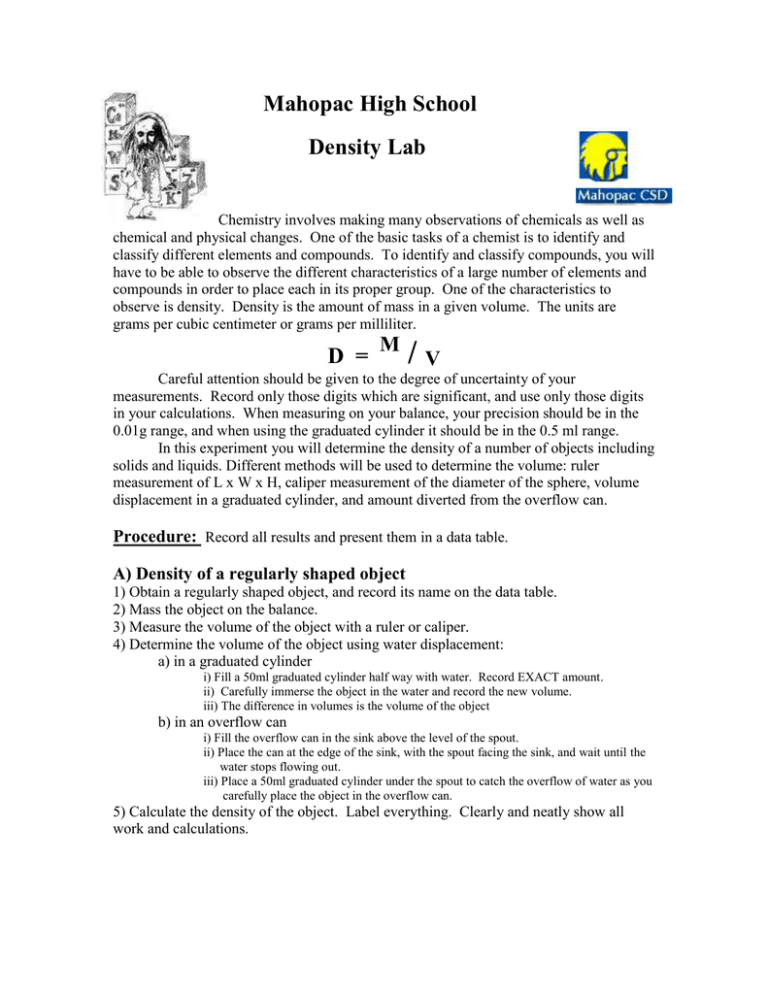Density Lab
advertisement

Mahopac High School Density Lab Chemistry involves making many observations of chemicals as well as chemical and physical changes. One of the basic tasks of a chemist is to identify and classify different elements and compounds. To identify and classify compounds, you will have to be able to observe the different characteristics of a large number of elements and compounds in order to place each in its proper group. One of the characteristics to observe is density. Density is the amount of mass in a given volume. The units are grams per cubic centimeter or grams per milliliter. D = M /V Careful attention should be given to the degree of uncertainty of your measurements. Record only those digits which are significant, and use only those digits in your calculations. When measuring on your balance, your precision should be in the 0.01g range, and when using the graduated cylinder it should be in the 0.5 ml range. In this experiment you will determine the density of a number of objects including solids and liquids. Different methods will be used to determine the volume: ruler measurement of L x W x H, caliper measurement of the diameter of the sphere, volume displacement in a graduated cylinder, and amount diverted from the overflow can. Procedure: Record all results and present them in a data table. A) Density of a regularly shaped object 1) Obtain a regularly shaped object, and record its name on the data table. 2) Mass the object on the balance. 3) Measure the volume of the object with a ruler or caliper. 4) Determine the volume of the object using water displacement: a) in a graduated cylinder i) Fill a 50ml graduated cylinder half way with water. Record EXACT amount. ii) Carefully immerse the object in the water and record the new volume. iii) The difference in volumes is the volume of the object b) in an overflow can i) Fill the overflow can in the sink above the level of the spout. ii) Place the can at the edge of the sink, with the spout facing the sink, and wait until the water stops flowing out. iii) Place a 50ml graduated cylinder under the spout to catch the overflow of water as you carefully place the object in the overflow can. 5) Calculate the density of the object. Label everything. Clearly and neatly show all work and calculations. B) Using density concepts in a practical problem. 1) Obtain a large piece of aluminum foil (approximately 30cm x 30cm) 2) Using 2.7 g/cm3 as the density for aluminum, substitute in all the known values to calculate the thickness of the aluminum foil (too small to measure with a ruler or caliper). Hint: Thickness in this case could also be called height 3) Clearly label and show all work for this calculation. C) Density of water 1) Measure the mass of your clean, dry graduated cylinder (or tare the scale with the graduated cylinder on it) 2) Add exactly 7ml of distilled water and reweigh. 3) Determine mathematically the density of water. D) Density of an unknown liquid Follow the procedure in part C using the unknown liquids provided. Conclusion Questions: Show all work. Q1) Using the measured volume as the “actual” measurement, calculate the percent error of the graduated cylinder volume displaced density, and of the overflow can density. Q2) Why won’t the volume displaced method work for all objects? Q3) What are two other factors that could effect the densities calculated with our objects in lab? Explain. Q4) What is the difference between density and specific gravity? Q5) The volume of a graduated cylinder changes from 35ml to 53ml when a 16.4g object is immersed in the water. Calculate the density of the object. Q6) An aluminum ball measuring 35.6g has a density of 2.5 g/cm3. What is the volume of the aluminum ball? Section A – Density of a Regularly Shaped Object – Metal Blocks Object Length(cm) Width (cm) Height (cm) Mass (g) Density (g/mL) Rectangle Cube Section A – Density of a Regularly Shaped Object – Spheres Object Black sphere Volume (mL) Mass (g) Density (g/mL) Mass (g) Density (g/mL) Metal sphere Section C – Density of Water Object DistilledWater Volume (mL) Tap water Section D – Density of an Unknown Liquid Object Unknown 1 Unknown 2 Volume (mL) Mass (g) Density (g/mL)



